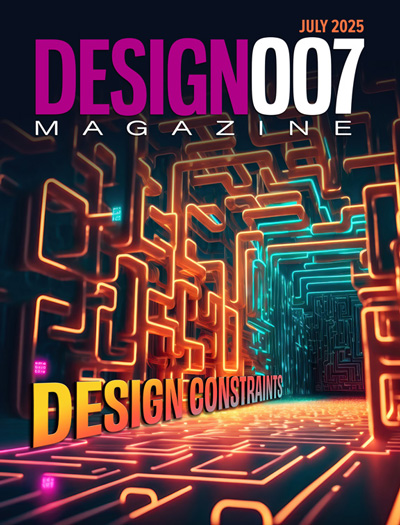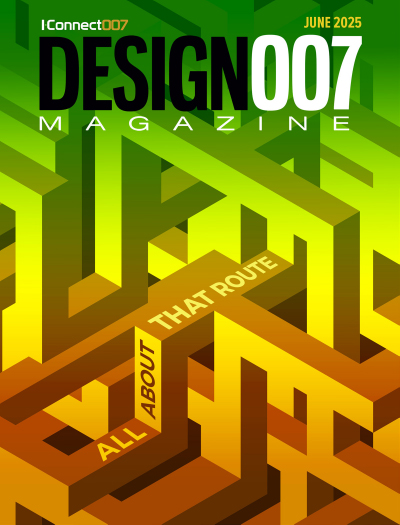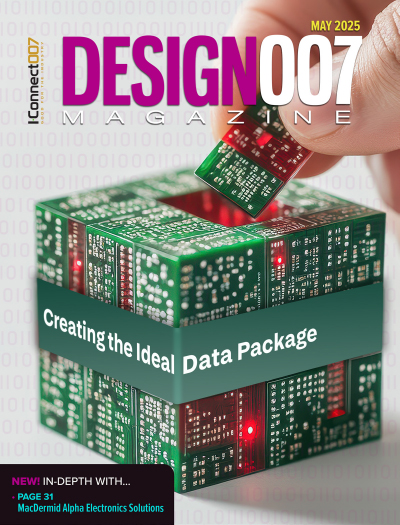-

- News
- Books
Featured Books
- design007 Magazine
Latest Issues
Current Issue
Showing Some Constraint
A strong design constraint strategy carefully balances a wide range of electrical and manufacturing trade-offs. This month, we explore the key requirements, common challenges, and best practices behind building an effective constraint strategy.

All About That Route
Most designers favor manual routing, but today's interactive autorouters may be changing designers' minds by allowing users more direct control. In this issue, our expert contributors discuss a variety of manual and autorouting strategies.

Creating the Ideal Data Package
Why is it so difficult to create the ideal data package? Many of these simple errors can be alleviated by paying attention to detail—and knowing what issues to look out for. So, this month, our experts weigh in on the best practices for creating the ideal design data package for your design.
- Articles
- Columns
- Links
- Media kit
||| MENU - design007 Magazine
PCB Design in the Age of IoT
June 6, 2017 | Ted Pawela, AltiumEstimated reading time: 1 minute
From the early days of printed circuit boards, the electronics industry has made huge strides in board materials, copper printing methods, miniaturization, rigid-flex, ELIC, EDA, and much more. Many of the devices we use in our homes, our vehicles, and in our workplaces would not be possible without this continuous evolution of PCB design and technology. And yet in 2017, we are poised to shift from evolution to revolution, driven by the idea of the Internet of Things.
By now we’ve all heard of IoT and have been presented with a multitude of definitions for it. We’ve also been presented with a set of benefits that sound nice, if not compelling: refrigerators that can tell us when to restock groceries, cars that can avoid traffic, home thermostats and lighting that can be adjusted from our offices, and so much more. But these examples trivialize what the IoT will become and the impact it will have on us. When realized, the IoT will transform our world from a collection of independent “things” into an organized system with logic, reasoning, senses, circulation, and motor skills. In other words, all of the devices and systems in our world will become an organism.
This might sound scary, and will no doubt evoke visions of dystopian societies where machines rule humans, but that’s only because movie scripts need a mechanism called an “inciting event” upon which to build an exciting story. In real life, this story doesn’t need to be scary; in fact, it holds the promise of a world of possibilities to make life safer, healthier, more convenient, and just plain better.
Imagine vehicles that can sense a problem before it occurs, and arrange for parts to be put into dealer inventory and service to be performed for you, all without you ever making a single phone call, and certainly without the roadside breakdown. Picture a farm with the intelligence to sense an increasing pest insect population and release pheromones that disrupt mating cycles—reducing the need for chemical pesticides and ultimately making our food supply safer, healthier, and more abundant.
To read this entire article, which appeared in the May 2017 issue of The PCB Design Magazine, click here.
Testimonial
"We’re proud to call I-Connect007 a trusted partner. Their innovative approach and industry insight made our podcast collaboration a success by connecting us with the right audience and delivering real results."
Julia McCaffrey - NCAB GroupSuggested Items
Statement from the Global Electronics Association on the July 2025 Tariff on Copper Foil and Electronics-Grade Copper Inputs
07/31/2025 | Global Electronics AssociationWe are disappointed by today’s decision to impose a 50% tariff on imported copper foil and other essential materials critical to electronics manufacturing in the United States.
Considering the Future of Impending Copper Tariffs
07/30/2025 | I-Connect007 Editorial TeamThe Global Electronics Association is alerting industry members that a potential 50% tariff on copper could hit U.S. electronics manufacturers where it hurts.
Connect the Dots: Sequential Lamination in HDI PCB Manufacturing
07/31/2025 | Matt Stevenson -- Column: Connect the DotsAs HDI technology becomes mainstream in high-speed and miniaturized electronics, understanding the PCB manufacturing process can help PCB design engineers create successful, cost-effective designs using advanced technologies. Designs that incorporate blind and buried vias, boards with space constraints, sensitive signal integrity requirements, or internal heat dissipation concerns are often candidates for HDI technology and usually require sequential lamination to satisfy the requirements.
OKI Launches Rigid-Flex PCBs with Embedded Copper Coins Featuring Improved Heat Dissipation for Space Equipment Applications
07/29/2025 | BUSINESS WIREOKI Circuit Technology, the OKI Group’s printed circuit board (PCB) business company, has developed rigid-flex PCBs with embedded copper coins that offer improved heat dissipation for use in rockets and satellite-mounted equipment operating in vacuum environments.
Designers Notebook: Basic PCB Planning Criteria—Establishing Design Constraints
07/22/2025 | Vern Solberg -- Column: Designer's NotebookPrinted circuit board development flows more smoothly when all critical issues are predefined and understood from the start. As a basic planning strategy, the designer must first consider the product performance criteria, then determine the specific industry standards or specifications that the product must meet. Planning also includes a review of all significant issues that may affect the product’s manufacture, performance, reliability, overall quality, and safety.


